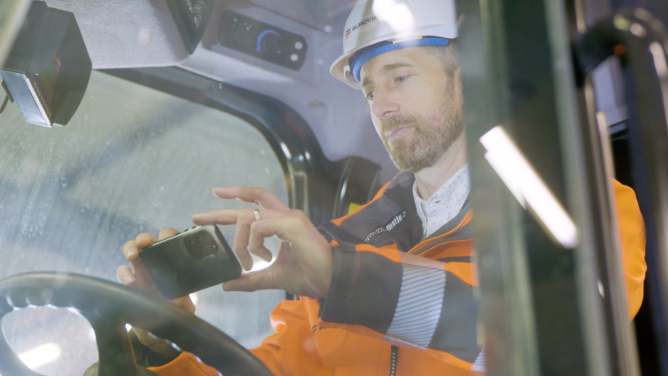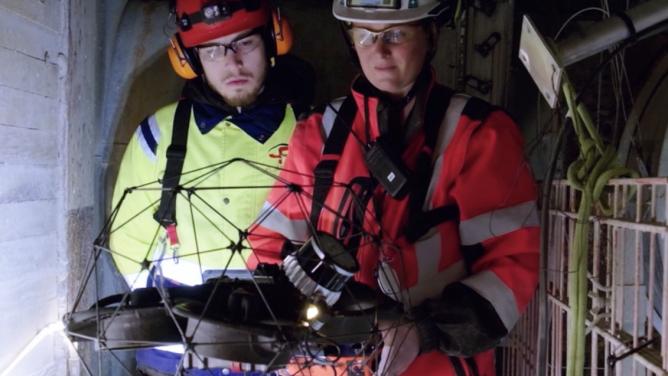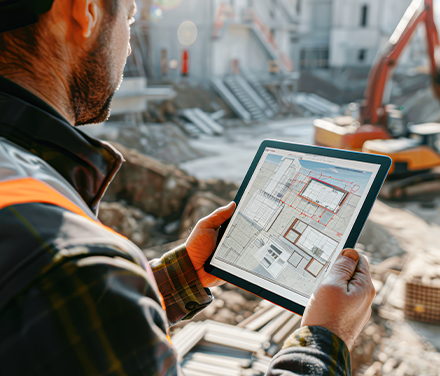Zero-accident culture
According to the French health care system, with 56 incidents recorded per 1,000 employees against an all-sector average of 34 per 1,000, the construction industry is one of the sectors most affected by workplace accidents. But it’s also one that has worked the most – for several decades – to break the glass ceiling. All types of innovative solutions are popping up: from a basic red carpet which marks out onsite traffic areas at VINCI Construction France, to exoskeletons which make strenuous tasks easier, as well as onsite AI video analysis that detect safety risks. From high tech to low tech, anything goes…
Ten years ago, VINCI adopted the zero-accident approach, which promotes a culture of prevention on construction sites. It is split into several areas: risk analysis, adequate visitor safety, work organization, and awareness. Each employee – whatever their hierarchy – is thus acclimatized to risks and encouraged to report any “near accidents” they see. The underlying idea is to continuously improve processes, as well as generalizing the highest standards across the various sites and countries where the group operates.
Moving away from accidentology
At the center of these concerns is the very philosophy of onsite safety. For decades, the prevailing approach was one of safety in the strictest sense, that is: workplace accidents. With a better understanding of chronic diseases and the risks associated with certain materials, the areas of safety when applied to heath have expanded.
As Prevention Director at VINCI Construction Grands Projets, Eric Denys can attest to this development, which is embodied in his job title. “I started out as HSE director, or rather health, safety and environment. By gaining maturity on these issues, we gradually appointed a prevention director who brings together health and safety on the one hand, and an environment director on the other.”
“Health and safety differ temporally. Avoiding or recording an incident is in the present. Whereas health has a long-term vision: like having back problems due to lifting excessive loads over many years, exposure to noise or asbestos...” The real issue is thus detecting risks and being able to monitor an employee throughout their career. By carrying out such follow-up care, HR departments are gradually becoming central players on such issues.
Collective solutions
On these issues, as construction sites have become more mechanized, the level of strenuity of work has greatly improved. Just take cement production, which is now produced upstream and handled onsite by machinery. The arrival of 3D concrete printing could push this logic even further by eliminating formwork, drying or handling and loading issues. Regarding noise, VINCI systematically carries out audiograms during medical checks and provides molded earplugs for each of its employees. The group is also carrying out pilot projects to measure dust dispersion and better understand the problems associated with silica.
“In my opinion, innovation in the way of thinking had a huge impact in terms of health,”explains the Prevention Director. “Five years ago in some companies, there was the impression that if something were to be successful, the idea had to come from above. Now all that’s changed. We ask those who do the work for their opinions and what should be done to make things better. Of course, this doesn’t result in big transversal changes, but everyone is involved, which means that the solution will be much easier to implement, and above all, it will be more realistic and more relevant. The solution can only be collective.”
Positive health
In a way, it’s easy to recognize the influence of the WHO definition of health when it comes to developments in prevention. Indeed, this defines health as “a state of complete physical, mental and social well-being and not merely the absence of disease or infirmity.”It’s a very broad, positive definition which pulls practices upwards by including problems of a psychological nature and living conditions off the construction site.
However, it comes up against obstacles that are still difficult to overcome, especially concerning major projects developed around the world, with differing cultures and legislation. Eric Denys notes that working habits are sometimes harder to change in industrialized countries than in emerging ones. However, he believes that the construction industry “is performing much better than 20 years ago. There is still room for improvement but we are doing very interesting things. Our approach and attitude are maturing greatly.”


